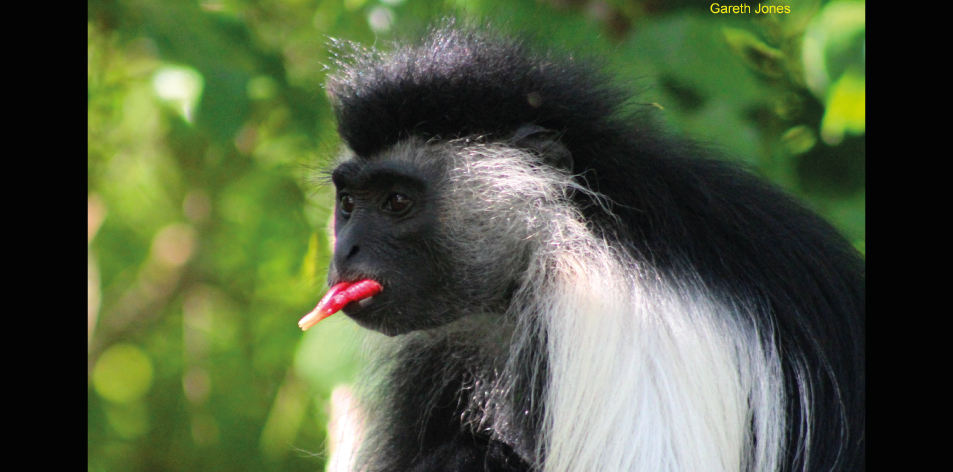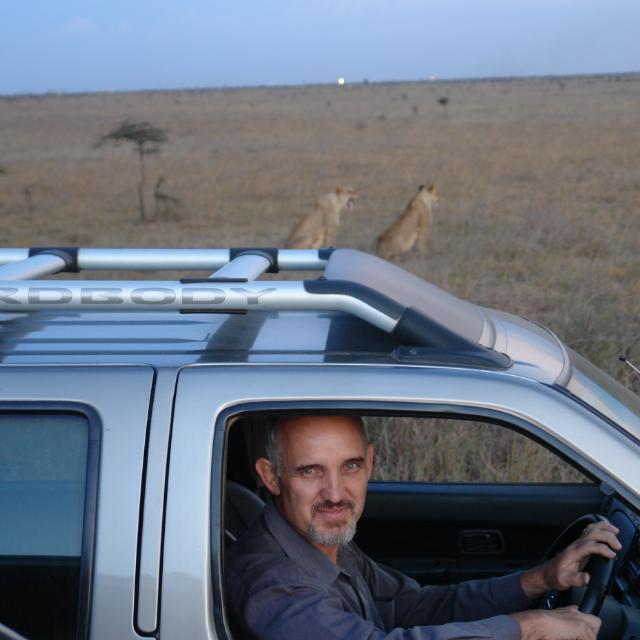
Colobus Monkeys- Article by Gareth Jones
COLOBUS MONKEYS IN DIANI!
Early one morning, I walked out behind our accommodation at Diani Beach Chalets to explore the natural sights. Suddenly a movement caught my eye, it was a colobus monkey in a tree above me. Then I saw more movement in the tree canopy above me, as an entire troop of more than ten colobus monkeys slowly emerged. As I watched them, they were quite relaxed as they fed on green leaves. Then they jumped onto the low flat roofs on the chalets and began to play-chase each other over the roofs. Eventually, they settled on one roof with a bit of shade for a short time, as they sat preening and cleaning each other, and mothers suckled their babies. Then as if on command they all began to move off in the direction of a valuable patch of untouched forested land. They were also joined by a troop of Sykes monkeys as they also selected flowers to eat for breakfast, nothing like a bit of ‘flower power’ to start the day. They disappeared over the wall and into the tall treed canopy of the vacant untouched area next door.
Many people do not know much about colobus monkeys. Interestingly I found some information that suggests the name Colobus comes from the Greek word “Kolobus” meaning maimed or deformed due to the fact that they do not have thumbs on their forelimbs. It appears that their lifestyle of adapting to live in the tree canopy does not require the use of thumbs.
It is a very special privilege to be able to visit a coastal town and see wild species like colobus monkeys. Diani is such a place, however, it should be noted that the tremendous growth of Diani from a village to a coastal town over the last 25 years or so has been a major threat to the future of wildlife in the area. The construction developments have included many hotels, villas, shops, roads etc, plus the installation of many electric power lines to supply power. The original forest cover has been reduced drastically by as much as 75 %, but thankfully there have been individuals and organisations who have highlighted the plight of the colobus monkeys in order to save them from certain extinction in Diani area. Most prominent in protecting the colobus monkeys is the Colobus Conservation. When speaking about a single Colobus the Digo local people use the word is Mkuluzu whereas if they are in a group they are called Wakuluzu. Nowadays locals call the Colobus monkey Mbega.
In Africa there are genera of colobus are all more or less thumbless and can be distinguished by colour: black-and-white colobus (genus Colobus), red colobus (genus Piliocolobus), and olive colobus (genus Procolobus). The five species of black-and-white colobus are slender, with long silky fur. The best-known species is the Abyssinian colobus, of the East African mountains, including Mount Kenya and Kilimanjaro. This colobus has a long beautiful veil of white hair along each flank and a long white brush on the tail. Lesser known is the Angolan Colobus monkey which has six subspecies in Africa of which the subspecies (Colobus angolensis palliatus) also known as Peters’s Angola colobus or Tanzanian black-and-white colobus is a rare species. Diani has a population of only about 400 of these rare colobus monkeys, and their entire population is thought to be less than 2000 individuals. Therefore the subspecies Colobus angolensis palliates is declared as endangered in the ICUN (World Conservation Union) red data list.
They eat mainly green leaves for many hours of the day, including flowers and some fruits. Colobus, unlike other monkeys, do not bother humans when it comes to food. They prefer their natural diet. In Diani apart from the habitat loss, other threats include crossing roads and electric power lines. Thankfully the efforts of those concerned have resulted in a number of special “colobridges” in the form of suspended ladders to allow them to cross the main road in relative safety. A high number of colobus monkeys were also getting electrocuted when touching the power lines, in recent times efforts have begun to insulate power lines to reduce the threat. However, there are still many electric overhead power lines that are naked and live. Colobus Conservation works in collaboration with the Kenya Power and Lighting Company (KPLC). In 2017, KPLC removed 12 km of uninsulated power lines in Diani and replaced them with insulated lines. They also moved transformers which given their location, were causing multiple primate electrocutions. It would be great if the Kenya Power & Lighting Company ( KPLC ) could refresh the active initiative to protect the Diani colobus monkeys by accelerating the rate of insulating the remaining naked live power lines. Such an action would also show that KPLC has compassion and caring for Kenya’s unique wildlife, maybe they should call the initiative “Colobus Care”?
For those who visit Diani I encourage you and your friends and family to take some time to observe and appreciate the wonderful colobus monkeys, they are truly a delight to watch. Our choice of accommodation is often to stay at self-catering places that are in natural peaceful settings with large trees. Diani Beach Chalets is such a place, well-positioned near the Colobus Conservation along Diani beach road. However, there are also a number of other accommodation options that also have conservation ethics, like “DO NOT FEED MONKEYS”, for a number of good reasons that include feeding them wrong foods and also making them semi-tame and therefore exposed to un-natural behaviour amongst tourist crowds. Please also be encouraged to visit the Colobus Conservation organisation, there is much to learn about the colobus monkeys at the information centre. Plus there is a small shop that sells items for fundraising. As you get involved in ensuring the future of these rare colobus monkeys, so your holiday will also become an enriching experience as you partake in something especially meaningful. It is also hoped that in the near future there will be many more people who call themselves “friends of the Diani Colobus Monkeys”.
We need to all ask ourselves, what future home we are leaving for the wildlife of Diani? We, humans, are the invaders, we are the ones who have destroyed their home habitat. Consider for a moment what Diani Beach strip will be in the coming years? This current generation can do much to leave a positive legacy of conservation success. A conservation success that ensured the future of the Diani Colobus Monkeys. Be the future, get involved NOW!!! I hope you all really make the most of your next Diani Beach Holiday! May God bless those who protect our wildlife!
Gallery


